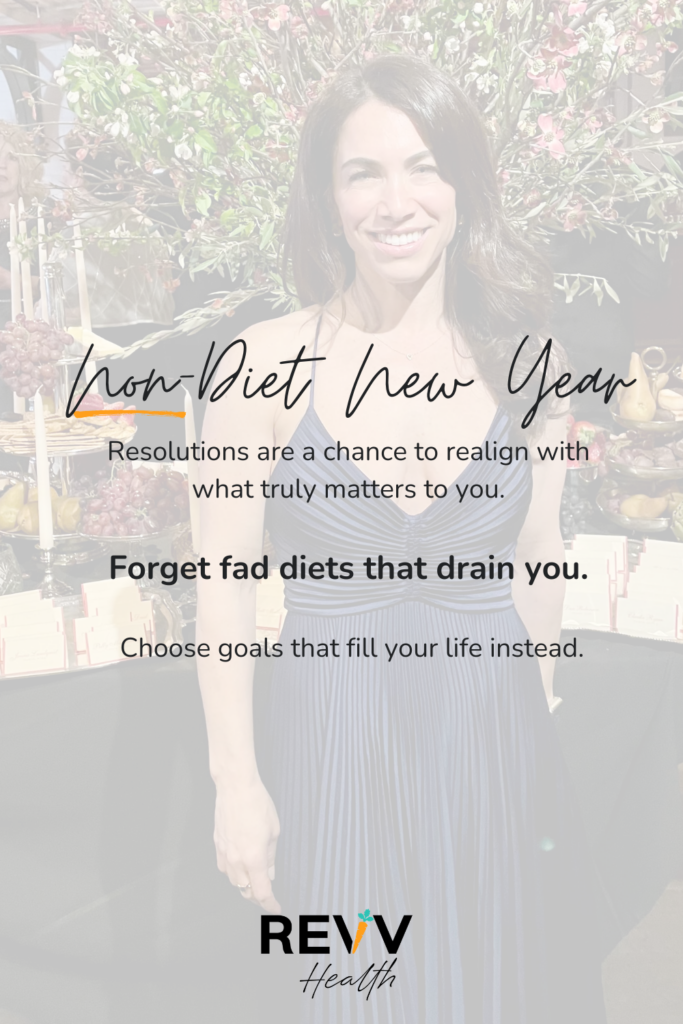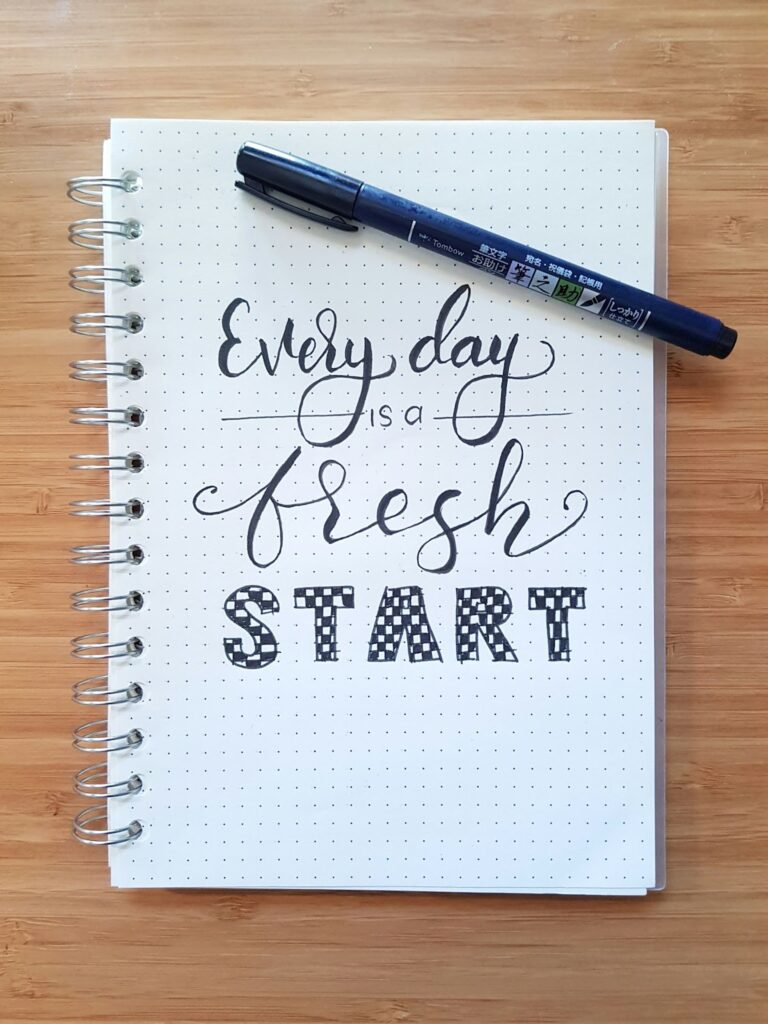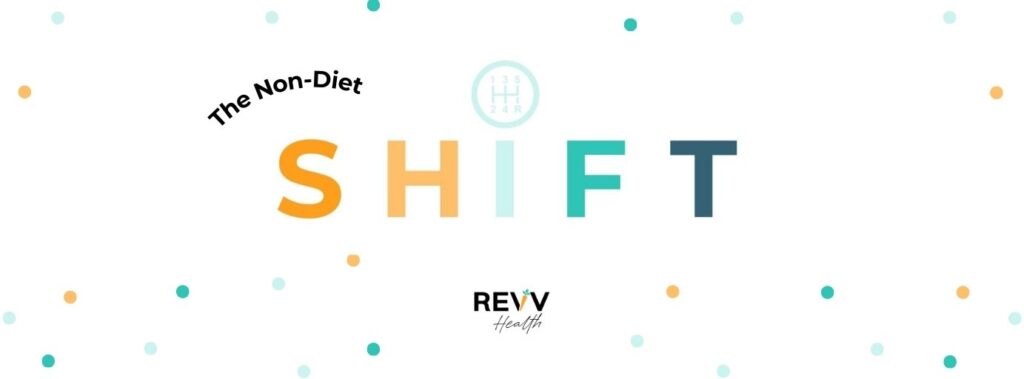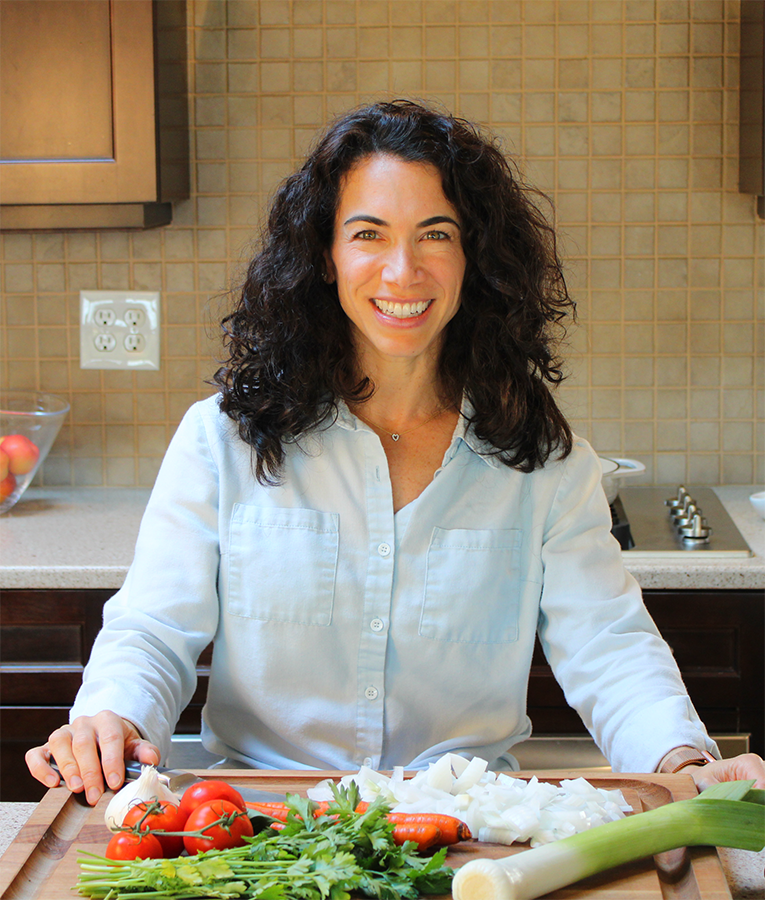So, you’ve decided! This year, no more diet resolutions that never work. No more calorie counting, no obsessing over meal plans, and definitely no squeezing into clothing that makes you feel bad about yourself!
Feels freeing, doesn’t it? But now that you’re skipping the usual January diet culture madness, you might be wondering,
“What kind of resolution actually feels right to make?”
If you’re new here, hey! I’m Marissa, and I am a non-diet registered dietitian nutritionist (RDN), parent nutrition coach, and eating disorder specialist. Around here, we like to do things a little differently, aka, ditch diet culture and lean into what actually works in real life.
In this blog, I’m sharing 14 non-diet, alternative New Year’s resolutions that will inspire you to kick off the year feeling empowered and excited!
A note on health and non-diet New Year’s resolutions
First, let’s clear something up right from the start: choosing non-diet resolutions doesn’t mean you’re giving up on your health. In fact, it’s quite the opposite.
Diet culture teaches us that weight loss equals health, even when the methods used – like restrictive diets, overexercising, or obsessing over food – are harmful and unsustainable. Not to mention that these approaches often backfire, leaving you feeling frustrated, disconnected from your body, and no healthier in the long run.
Non-diet resolutions, on the other hand, focus on nourishing your body, mind, and soul in ways that are truly health-promoting!
Non-diet resolutions help you:
- Build habits that improve energy,
- Reduce stress,
- And support your entire well-being without fixating on a number on the scale.
Committing to your health isn’t asking yourself, “How can I shrink my body?”.
Instead, it’s asking, “How can I care for myself in a way that feels right for me and lasts?”.
These non-diet, alternative New Year’s resolutions are here to help you build habits that honor your well-being without all of the guilt, shame, and quick dieting strategies.
Stop! Do this first.
Before diving into these non-diet, alternative New Year’s resolutions, take a step back and reflect on the year you’ve just lived.
Ask yourself:
- What moments brought me the most joy this year? Big or small, what made you smile, feel connected, and lit up?
- What challenges did I overcome? Give yourself credit for the strength you may have shown, even in hard times.
- What did I learn about myself? Did you discover new priorities or passions?
- What am I grateful for? Reflecting on the good, no matter how small, can set a positive tone for the year ahead.
Consider journaling your answers to the above questions or even creating a “year in review” list. It doesn’t need to be perfect or profound… just honest.
Because before you can look ahead, it’s really powerful to pause and say, “This is where I’ve been, this is where I am now, and this is where I want to go.”
As the (paraphrased) Cheshire Cat from Alice in Wonderland so wisely says: “If you don’t know where you’re going, how will you know when you’ve arrived?” (source).
OK, now that we’ve done all the pre-work, let’s look ahead and explore some awesome new goals that will really give you some bang for your buck.
1. Adding versus subtracting
One of the very first things I like to work on with my clients is helping them reframe how they think about food.
Instead of focusing on what to cut out, I usually have them start by thinking about what they can add to their day.
Why? Because focusing on what you “can’t” have creates a scarcity mindset, which often leads to feelings of deprivation and frustration (ahem, dieting).
On the other hand, having an “abundance mindset” feels more positive and realistic.
If you think about it, what’s more appealing: deciding you’ll “cut out carbs” or finding ways to add colorful veggies, satisfying protein options, or new flavors to your meals?
Adding feels like self-care. Subtracting feels like punishment.
This approach doesn’t just relate to food, either.
It’s a mindset that can actually shape how you approach your entire day. Whether it’s:
- Adding movement that feels joyful, not forced.
- Building in moments of intentional rest: even just five minutes to breathe, stretch, or recharge.
- Incorporating small pleasures like reading a chapter of a book or enjoying your favorite tea.
Focusing on addition helps create a life that feels full and doable, not restricted.
If there was ever a way to slap the dieting industry in the face, this would be it 🙂.
What’s one thing you could add to your meals or your life this year that feels exciting and nourishing?
That’s where I’d start.
2. Setting boundaries like a pro
One of the most empowering resolutions you can make this year is learning to set boundaries and say “no” politely.
Whether it’s declining an invite, protecting your time, or standing firm on decisions about your body and health, saying “no” is a valuable asset.
But, if you are not used to setting boundaries, saying no can feel awkward or even selfish.
That’s why I like having polite “no, I won’t” scripts that live in the notes section of my phone as a reminder.
P.S. Feel free to steal these below!
Scripts for setting kind boundaries
- When you’re overwhelmed by requests
What to say: “I’d love to help, but my plate is really full right now. I need to focus on my priorities, so I’ll have to pass this time.”
- When you’re protecting your energy
What to say: “Thank you for thinking of me, but I am not getting enough rest right now. I hope you understand.”
- When someone questions your choices
What to say: “This is what feels best for me right now, and I appreciate your support in that.”
- When you’re asked to overcommit
What to say: “I want to be upfront that I may not be able to give it the attention it deserves right now, so I’ll need to say no. I hope you understand, and I wish you the best in finding the right support!”
- When you just don’t want to
What to say: “Thanks for inviting me, but I’m going to pass this time. I hope it goes well!”
3. Limit the scroll
Ever feel like you just sat down to check one notification, and suddenly you’re neck-deep in a doom-scrolling rabbit hole?
I wish I could say this wasn’t common. But it happens to all of us (including me!). And saying “never” for this to happen again isn’t realistic.
So, instead of swearing off the doom scroll completely, here are some alternative, realistic ways of reclaiming some of that time (and sanity) from your screen.
- Start by setting boundaries (see #2 above) that feel realistic for you. Maybe it’s declaring the dining table or your bedroom a no-phone zone. Or using an app to remind you to take screen breaks.
- Replace the scroll. Try doing something more fulfilling in its place. Stash a book, journal, or puzzle nearby for easy access. Try deep breathing or listening to music instead.
- Set a timer. Sometimes, you just want to scroll, and that’s totally okay! Try to be intentional about it. Set a 15-minute timer to keep yourself in check, or use app features that remind you when you’ve hit your daily limit so that instead of never scrolling, you make sure it doesn’t take over your day or evening.
4. Challenge the diet mentality directly
Dieting goals can sneak up on you, especially if they’ve been a January habit for years.
“Maybe I’ll just try cutting carbs again,” or “I need to lose X pounds to feel better.”
When those nagging thoughts arise, pause for a moment and ask yourself: “What am I really craving?”
A little secret: most dieting goals aren’t actually about food.
They’re often tied to a deeper desire: a need for control during stressful times, comfort when life feels overwhelming, or connection when you feel disconnected from yourself or others.
For example:
- Craving control? Maybe what you need is structure in a different area of your life, like a morning routine or a clean, calm workspace.
- Craving comfort? Instead of restrictive food rules, try creating small rituals that soothe you, like curling up with a cozy blanket and a book, taking a bath, or baking a nostalgic recipe.
- Craving connection? Dieting can sometimes be a stand-in for wanting to feel seen or understood. Build your resolution around deeper connections, such as reaching out to an old friend, spending time with loved ones, or journaling to reconnect with yourself.
When you can get curious about what you’re really craving, it opens up space to set goals that meet your actual needs versus ones that punish or restrict you.
5. Start a body appreciation practice
When was the last time you paused to thank your body? No, not for how it looks, but for what it does for you every day?
Diet culture trains us to criticize our bodies.
But, shifting toward a body appreciation practice can be a powerful antidote. This year, commit to noticing the small, everyday ways that your body shows up for you.
Try starting a body appreciation journal:
- Each day, write down one thing your body did for you. It could be as simple as:
- “My legs carried me through a walk in the sunshine.”
- “My arms hugged my daughter tightly when she needed comfort.”
- “My lungs let me breathe deeply when I felt anxious.”
- “My hands helped me cook a meal I enjoyed.”
This practice does not ignore the challenges or discomfort that you might be experiencing in your body. Rather, it creates the mindfulness to recognize your body’s strength and value beyond appearance.
Over time, these small acknowledgments can help you rebuild trust and connection with your body. Because your body does so much for you every single day.
6. Create this year’s value-driven health statement
Health goals tend to stick when they’re based on something meaningful: your core values.
Instead of focusing on superficial goals or arbitrary rules, shift your focus to what actually matters to you.
Start by identifying your core values. Things like:
- Connection
- Kindness
- Adventure
- Growth
- Creativity
- Rest
- Etc.
Then, create a simple statement that aligns with those values – something that is personal to you and purpose-driven.
Here are some examples:
- If connection is your value: “I want to eat more meals with my family because sharing food brings us closer.”
- If rest is your value: “I’ll prioritize 7-8 hours of sleep each night because feeling rested helps me show up as the best version of myself.”
- If adventure is your value: “I’ll try one new activity each month because it energizes me and keeps life exciting.”
- If kindness is your value: “I’ll speak to myself with the same compassion I show my loved ones.”
A value-driven health statement acts like a guidepost, helping you focus on goals that feel fulfilling, not punishing.
So next time you are knee-deep in summer-time mode and far away from your January goals, you can circle back to the values that truly matter to you versus what you should do.
Take a moment to reflect: What are your values? How can you let those values guide your health decisions this upcoming year? Once you have your statement, write it somewhere visible to remind yourself of your why every day.
7. Cultivate radical self-compassion
If you wouldn’t say it to a friend, why say it to yourself? Because we are so much harder on ourselves.
So many of us hold ourselves to impossible standards, punishing every little mistake and expecting perfection.
This year, what if you treated yourself with the same kindness, patience, and understanding that you’d offer someone you care about?
Radical self-compassion helps you let go of the “inner critic” and embrace the part of you that knows you are enough, exactly as you are.
Here’s how to start:
- Talk to yourself like a friend.
- The next time you catch yourself in a spiral of self-judgment, pause and ask: “What would I say to my best friend in this situation?” Then, offer those same words to yourself.
- Let go of unrealistic expectations.
- Perfection is a myth. Give yourself permission to do things well enough, whether it’s a workout, a meal, or a day at work.
- Practice forgiveness, especially on tough days.
- Didn’t get everything done today?
- Ate more than you intended?
- Felt overwhelmed?
- That’s okay. Remind yourself: “I’m human, and I’m doing the best I can.”
- Celebrate your small wins.
- Start noticing the little victories that often go overlooked.
- Did you take a 10-minute walk?
- Cook dinner when you didn’t feel like it?
- Rest when your body asked for it?
- Those are all worth celebrating.
- Start noticing the little victories that often go overlooked.
- Create a self-compassion mantra.
- When you’re struggling, repeat a grounding phrase, like:
- “I’m worthy of love, even when I’m not perfect.”
- “I’m allowed to take up space.”
- “I’m doing enough. I am enough.”
- When you’re struggling, repeat a grounding phrase, like:
Cultivating radical self-compassion is learning how to be on your own team.
8. Celebrate food traditions
Food is so much more than fuel.
Food is connection, comfort, and a bridge to memories.
This year, instead of worrying about “good” or “bad” foods, what would it be like to celebrate the traditions that bring joy, meaning, and connection to your life?
Revisiting or creating food traditions can be a beautiful way to honor your culture, share special moments with loved ones, or even reconnect with yourself.
Here are a few ideas to inspire you:
- Bake a family recipe: dust off an old family recipe and spend time recreating it. Whether it’s your grandmother’s famous cookies or a dish from your culture, let it transport you back to a time or a place that feels warm and comforting.
- Host a “comfort food potluck”: invite friends or family to bring their favorite comfort foods. Not only does this create a table full of delicious variety, but it’s also an opportunity to share stories and memories about the dishes you love.
- Start a weekly or monthly food ritual: whether it’s “pasta night,” “pancakes on Saturdays,” or a monthly pizza-making evening, let food become a joyful routine that you can look forward to.
- Celebrate seasonal eating: This is a favorite of mine, where we look forward to foods that feel cozy in winter (like soups or stews) or refreshing in summer (like fresh berries or garden vegetables).
- Share a food tradition with someone new: cook a dish that’s meaningful to you and teach a friend, partner, or child how to make it. Passing down food traditions creates connection and keeps those memories alive.
Food traditions remind us that eating is so much more than nutrients. What’s a food tradition that you can revisit, or better yet, start fresh this year?
9. Create a “no-pressure reading list”
Does your reading list feel more like a chore than something you look forward to?
Instead of “tackling books” you feel like you should read, try the Marie Kondo-style, “What book might spark joy or curiosity?”. “What sort of read will bring comfort or simply let you escape for a little while?”
I have what I call my “no-pressure reading list,” which is a list of books that have been recommended to me or ones that I have researched and that make me excited to dive into at some point.
Here’s how to get started:
- Choose books that light you up: What types of stories or topics feel intriguing? If it makes you happy, it belongs on the list.
- Mix it up: Give yourself permission to read what feels good in the moment. Mix light fiction with thought-provoking nonfiction, sprinkle in poetry, or revisit childhood favorites.
- Ditch the guilt: Didn’t finish a book? Didn’t read as much as you hoped? Who cares! Reading isn’t a competition. Put down what doesn’t hold your interest and move on to something that does.
- Make reading relaxing: Pair reading with something you love, like curling up on your sofa with a blanket and tea, take your book outside for some fresh air, or pop in an audiobook during a relaxing walk. A friend of mine pulls up a YouTube video of a fireplace while she reads; I mean, how awesome is that?!
A good book is everything! So, what’s the first book on your “no-pressure” stack this year?
10. Rediscover “joyful movement”
For many of us, movement and exercise have been tangled up with diet culture, treated like a punishment for what we ate, a way to “earn” our food, or just another item on our never-ending to-do list.
But what if movement wasn’t to shrink, burn calories, or “fix” your body?
What if you moved your body to simply feel good?
That’s at the heart of joyful movement.
And let’s be clear. “Joyful” doesn’t always mean grinning ear-to-ear while you move your body.
Joyful movement can be…
- Those days when you thought you couldn’t, but you did anyway!
- When you manage a workout without interruptions from the kids.
- Hitting a PR after a solid night’s sleep.
- Choosing gentle stretching because your body whispered (or shouted), “Today, I need rest.”
So how can you start moving like that?
Ask yourself one simple question: what makes movement feel good (feel right) to you?
Not sure where to start? Here are a few ideas to inspire you:
- Dance like no one’s watching: put on your favorite playlist and dance in your living room.
- Revisit a childhood favorite: think back to what you loved as a kid, maybe rollerblading, doing Skip-It, riding a bike, jumping rope, or playing at a trampoline park. Movement doesn’t need to be serious to be effective.
- Find movement in nature: go for a hike or stroll through your neighborhood. Moving outside adds the bonus of fresh air, sunshine, and a connection to nature.
- Try something new just for fun: ever wanted to try a dance class, learn pickleball, or take up kayaking? Try new activities without worrying about being “good” at them.
- Move mindfully: practices like yoga, tai chi, or stretching can be gentle, grounding, and a way to connect with your body’s needs.
What’s one way you can move your body this year that feels fun, energizing, or just plain silly?
11. Focus on health-focused habits, not weight goals
Many of my clients come to me fixated on a specific number on the scale, believing, “If I can just hit that number, everything will fall into place.”
It’s a story we’ve been sold for years. That weight equates to health, happiness, and success.
If we step back and reflect, you and I both know that chasing a magical number often leaves you feeling frustrated, exhausted, and very disconnected from your body.
What I help my clients see is that actual health comes from building habits that support how you feel in your body. This can lead to more energy, better sleep, less stress, and a sense of well-being.
Letting go of the scale can be scary, but it’s also freeing.
Because when you stop obsessing over a number, you can focus on what actually matters: habits that help you care for yourself in a way that feels good and sustainable.
Here are some ideas to help you shift the focus:
- Prioritize sleep: set a consistent bedtime routine to give your body the rest it needs.
- Hydrate regularly: make water more exciting by adding fruit, herbs, or sparkling options.
- Move in ways that feel good: see #10, “joyful movement” above. Explore movement that leaves you feeling energized and happy.
- Nourish, don’t restrict: focus on adding more variety, colors, and flavors to your meals instead of cutting things out. See #1.
- Manage stress: this one is so often overlooked. Try to incorporate simple tools like deep breathing, short walks, journaling, or mindfulness into your day. (And let’s not forget those boundaries, eh?)
What’s one small, health-focused habit you can start with today? Choose something that feels realistic, achievable, and, most importantly – good for you.
12. Meal plan with a new system in mind
Meal planning doesn’t have to be rigid, overwhelming, or driven by diet rules.
Instead of trying to eat “perfectly” or restricting yourself, shift your mindset to focus on nourishing your body with enough food so that you have the energy, clarity, and calm you need to get through the day.
So many people fall into the habit of muddling through meals while starving and grabbing whatever’s closest because they’ve tried to “eat light” or skipped meals earlier in the day.
But hunger isn’t something you can just ignore…it always catches up with ya!
This year, reframe meal planning with a new “why”:
- To give your body enough fuel so that you can feel your best.
- To reduce decision fatigue so that you can make easier choices.
- To reduce stress by having food readily available when you need it.
- To enjoy meals that are satisfying, realistic, and flexible versus something you’re forcing yourself to endure.
When you focus on creating meals that are good enough (physically and emotionally), you’ll start to feel more energized, less frantic around food, and more connected to your body’s needs.
Meal planning doesn’t have to be perfect. It just needs to work for you.
I have a digital meal planner that can get you started below.
13. Build your New Year coping toolkit
This year, instead of setting goals that add pressure to be perfect during hard times, try focusing on building out your coping toolkit. Aka: have that plan B in place, now!
A coping toolkit is a set of tools that helps you handle life’s tough moments with more ease and self-compassion.
When emotions run high (because life), you don’t need to go from overwhelmed to calm in two minutes. That is an unrealistic expectation.
Instead, equip yourself with small, actionable strategies that help you pause, regulate, and respond.
Here’s how to start:
- Body-based tools: stretch to release tension, shake it out with a quick movement, or press your feet into the ground to feel anchored.
- Sensory shifts: splash cold water on your face, put on a song that fits your mood, or use a fidget tool that you can carry to redirect your focus.
- Thought-based coping: ask yourself, “What’s actually in my control right now?” or reframe the moment: “This is hard, but I’m handling it.”
To make it work, keep your tools easy to access: save a “Coping List” on your phone, carry a small reminder in your pocket, or jot down strategies in a journal.
A coping toolkit isn’t just a resolution; it’s a life skill that can help you step into the new year with more calm and self-trust.
14. Prioritize the care you’ve been putting off
When life gets busy, it’s easy to put your own health on the back burner. Maybe you’ve been meaning to schedule that dental cleaning, book a therapy appointment, or finally get that pap smear … But it keeps slipping down the to-do list.
This year, make it a goal to prioritize your healthcare.
This doesn’t mean tackling every single overdue appointment all at once. Instead, recognize that your health deserves attention and care, too.
Here’s how to start:
- Make a list: Write down the appointments or check-ins you’ve been meaning to schedule, big or small.
- Start with one thing: Choose one appointment to book this month. Once it’s done, move on to the next. Baby steps!
- Consider supportive care: branch out from only scheduling medical check-ups. Maybe you want to schedule a therapy session, book a massage, or see a specialist for that nagging issue you’ve been ignoring.
Taking care of yourself isn’t indulgent; it’s foundational.
You deserve to feel well, and prioritizing this kind of care sets a powerful tone for the year ahead.
What’s one appointment or act of care you can schedule this week? Start there.
Share your non-diet, alternative New Year’s resolutions!
Did any of these non-diet, alternative New Year’s resolutions resonate with you? I would love to hear which ones you’re going to try in the comment section below.
Ready to take it a step further?
If you’re tired of diet culture dictating every New Year’s resolution and are looking for a different approach, my self-paced Non-Diet Shift Program is here to help.
This program will guide you toward a healthier, happier relationship with food, movement, and yourself without the guilt, shame, and rigid rules.
Cheers to making this the year you embrace healthy habits that actually work for you.













0 Comments